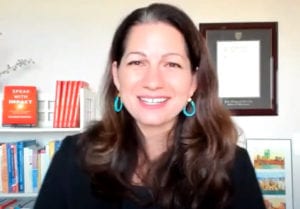Who is a member?
Our members are the local governments of Massachusetts and their elected and appointed leadership.

Allison Shapira conducts an interactive training session via Zoom with Women Leading Government, an initiative of the Massachusetts Municipal Management Association.
When the COVID-19 pandemic forced an abrupt switch to a virtual work environment, municipal employees and officials needed to acclimate to the world of online internal and public meetings quickly – and without much guidance or experience.
At the Dec. 10 meeting of Women Leading Government, an initiative of the Massachusetts Municipal Management Association, Allison Shapira conducted an interactive training session with 140 attendees focused on three strategies to be just as impactful and powerful in a virtual environment as in person: strategically preparation; speaking with presence; and speaking with precision on camera.
“Many of the benefits of a virtual world are not going away,” said Shapira, the founder and CEO of Global Public Speakers. “Expectations have been raised in terms of the accessibility and availability of the people in our community.”
Using an online polling tool, Shapira asked the group for words that describe the challenges of virtual meetings. Setting aside technical issues, the overwhelming majority named fatigue, staying engaged, and speaking up as the most difficult.
“Everyone needs these skills regardless of their role, background or gender,” Shapira said. “But it disproportionately affects women to not have these skills.”
Background and lighting are key when preparing for a virtual meeting, she said. Even when confined to a small space or when sharing space, she said, it’s important to control even one small corner as the background of your workspace, and make sure it is intentional and not distracting to viewers. Lighting should be consistent and in front of you to make sure you can be seen clearly, and the camera should be kept at eye level. Shapira then encouraged attendees to make one 30-second adjustment to improve their setup.
Meeting facilitators should practice in advance and be intentional about everything happening during the meeting with a well-planned agenda, she said, adding that “we could wing it more easily in person because we could pick up on cues in the room.”
It’s important to know the platform or software being used for every meeting, and what it allows.
The energy and cues we’re used to during in-person interactions are missing from the virtual environment, especially with the additional stress of a pandemic, but there are ways to recreate that energy by considering, and practicing, how to speak with intention, or focused energy, in front of a camera.
“In person, we are picking up on the energy in the room,” Shapira said. “But now we have to speak into a camera with no energy coming back to us.”
Attendees were asked to practice introducing themselves without intention, and then pausing, breathing and trying the same introduction with full intention. Attendees noticed that the latter sounded happier, more engaged, passionate, and more inviting.
Referring to this “executive voice,” Shapira said, “Intention isn’t yelling; it is a powerfulness that isn’t loud.”
The home environment has distractions that compete for our attention, and we can unintentionally ramble during online meetings due to nerves. Shapira introduced her PREP framework for speaking clearly and concisely: Point, Reason, Example and Point. The framework helps speakers organize their thoughts on the fly and helps rein them back in if they find themselves moving off topic. It can also be a valuable tool when answering difficult questions.
Shapira instructed attendees to practice the PREP method in breakout rooms, using issues municipal officials and employees routinely face and speak to during internal and public meetings. She recommended practicing the method before meetings, as well as easy transitional phrases, to help build “muscle memory.”
Following the training, attendees shared stories of “Zoom gone wrong” and tips for dealing with lessons learned over the past 10 months working in a virtual environment.